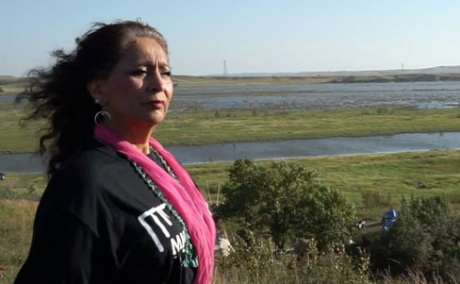Reports
You are here
Indigenous sovereignty from Standing Rock to Unist’ot’en

May 16, 2017
There is a new education and action force for climate justice in Ontario: the Indigenous Mobilization Team (IMT), created by the Ontario Public Service Employees Union (OPSEU) and the Chiefs of Ontario. The Team was created out of the first biennial OPSEU Indigenous Conference in the fall of 2016. Krista Maracle, Chair of the OPSEU Indigenous Circle, stated at the conference that “Indigenous communities already know what an effective strategy of healing and reconciliation would look like. They just need partners to help make it a reality. These initiatives are about OPSEU stepping up to be such a partner.’’
On May 5, 2017 over 150 people filled OPSEU’s downtown Toronto hall to share food and hear magnificent presenters invited by the IMT, including LaDonna Allard (Tamakawastewin/Brave Bull) from Standing Rock, and Freda Huson from Unist’ot’en camp. The hall was decorated with banners stating “Turtle Island, Indigenous Sovereignty, We Stand as One” and “Trump has no business in Standing Rock.”
Standing Rock
LaDonna Allard is a member of, and tribal historian for, the Standing Rock Sioux Tribe. She co-founded the Sacred Stone camp during last year’s opposition to the Dakota Access Pipeline. She was moved to action when she realized the pipeline would be next to her son’s grave – “Oh my god. It’s in my backyard.” As with so many other pipelines, neither the company nor the regulators or government obtained informed consent from the First Nation.
Allard pointed out the painful coincidence that happened on September 3, 2016, when the bulldozers arrived along with government-sanctioned attack dogs, paper spray, mace and lots of guns. This was the anniversary of the Wounded Knee massacre of 1890 on the nearby Lakota Pine Ridge reservation in South Dakota, when the cavalry killed nearly 300 Lakota.
In spite of this, the unity and solidarity displayed by the thousands of Indigenous activists from all over Turtle Island and beyond acted to give Lakota youth hope and pride in their culture and ceremonies.
The mainstream media then went on a smear campaign. By December, there were media accusations of “paid protectors” and the military sent in infiltrators to spread malicious gossip. These were unsuccessful attempts to “divide and conquer” the land and water protectors.
As of today, the pipeline has yet to be completed and the Lakota continue to use the land to teach youth how to “live green” using naturally available food and medicines.
LaDonna concluded with a call for unity among all those who wish to protect the earth and water. As she said, “Thanks to Standing Rock we saw empowerment of the people. There was healing, power, joy, prayer, laughter. We said “Stand up. Fight back.’ “
She asked everyone to support indigenous media, noting that social media played a very positive role at Standing Rock. She wrapped up by saying “The economic system has us by the throat. We can’t all afford electric cars, so every day we need to do something to divest from fossil fuel. Indigenous knowledge can save the world.”
Unist’ot’en Camp
Freda Huson travelled thousands of miles from the Unist’ot’en camp at Wedzin Kwa (near Houston or Smithers, BC), part of the territory of the Wet’suwet’en First Nation. The camp was established in 2010 as part of the resistance to seven different pipelines planned to traverse the area, including proposals by TransCanada, Enbridge and Pacific Trails pipeline companies and the Chevron oil company. The pipelines would transport both tarsands oil and fracked gas. Any of these pose enormous risks to the land and water, which, in turn, would have negative impacts on the people’s ability to hunt, fish and use plants for medicines, plus all the ceremonies associated with these activities.
As Huson explained, “We use facts, wisdom and prayer to make our points, not aggression.” The activists enforce a protocol that reflects the UN Declaration on the Rights of Indigenous Peoples, namely that Indigenous peoples have the right to prior, free and informed consent when considering resource extraction projects that affect their territories. When company workers arrive in the Wet’suwet’en territory near the camps, they are told that they do not have permission to be on the territory.
In addition to stopping pipelines, the camp (which contains a large cabin) serves as a forum for decolonization of both Indigenous and non-Indigenous participants, by organizing five-day “action camps.” Hundreds of people have taken part in the last three of these action camps. The group also started the Sacred Fire Network to connect all Indigenous activists and to train people to help out with other First Nations’ battles.
In 2015 construction began on a healing centre, which will primarily serve Indigenous youth who suffer trauma from the many tragic consequences of colonization. Allies raised $50,000 and donated labour to help build the centre.
Huson concluded by saying “The government did everything in their power to take the Indian out of our children. And we will do everything in our power to put the Indian back in the child.”
For more info see www.unistotencamp.com
Section:










